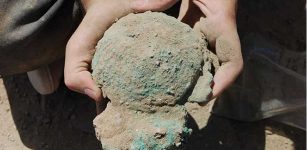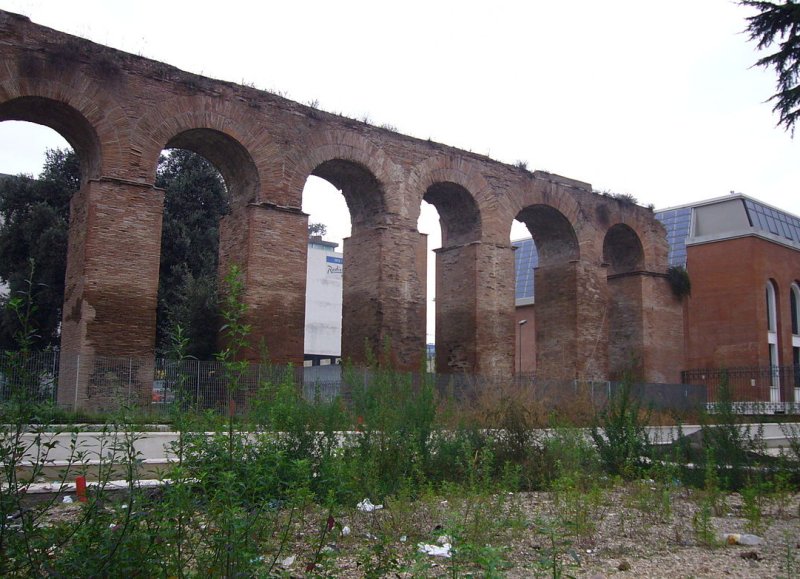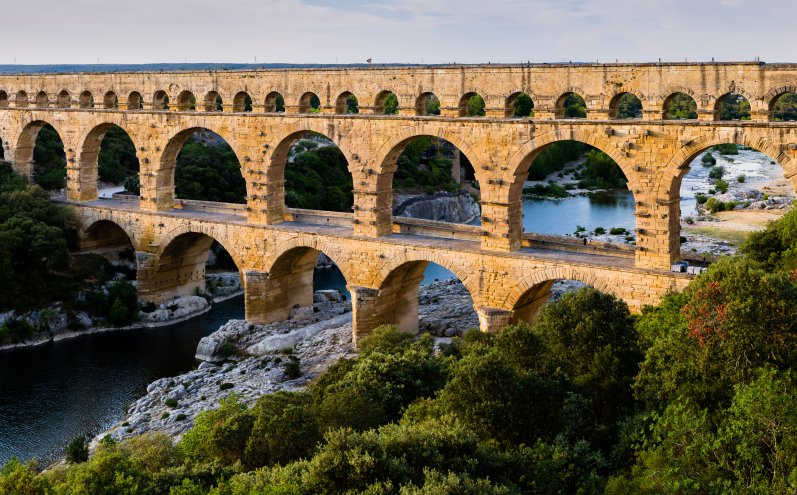Aqueducts Are Among Most Exceptional Achievements Of Ancient Roman Engineers
A. Sutherland - AncientPages.com - Among all the achievements of ancient engineering, Roman aqueducts belong to the most exceptional ones.
Engineers in the ancient Roman Empire knew that one of the most fundamental requirements for any town or city to exist was to supply it with water because it is a basic human need.
Ruins of the Aqua Anio Vetus, a Roman aqueduct built in 272 BC. Image credit: Lalupa - CC BY-SA 3.0
In 312 BC, a Roman politician Appius Claudius Caecus ordered that an aqueduct be built to supply Rome with water. The aqueduct was one of two major Roman projects carried out during this period; the other was a road for military purposes.
The city must have water to drink, cook, and clean, but it also must have all the necessary arrangements to remove unwanted water. Both ancient and modern Rome has been well supplied with the means for delivering water to the city and taking it away.
Ancient Romans were highly skilled engineers. By the early fourth century AD, Rome was being supplied by more than twelve aqueducts, which cooperatively could bring more than a million cubic meters of fresh water to the city daily!
This massive amount of water was delivered to Rome's inhabitants through a complex network of tanks and pipes and to about 1,500 public fountains, pools, and almost 900 public and private baths.
"With so many indispensable structures for so many aqueducts," remarked Frontinus, "compare, if you will, the idle pyramids or the useless, though famous, works of the Greeks…." wrote Sextus Julius Frontinus around AD 98, in his book called "De Aquis Urbis Romae" (About the Waters of the City of Rome).
Much of our Roman water supply system knowledge comes from this book. Frontinus was a prominent Roman civil engineer and the top official overseeing Rome's water supply. In his book, he described Rome's aqueducts.
The multiple arches of the Pont du Gard in Roman Gaul (modern-day southern France). Source
Usually, we think of the Roman aqueducts as a series of tall, impressive stone arches visible above the ground. Later, aqueducts included some (less than 10 percent) sections carried on massive arches.
However, the first aqueduct, the Aqua Appia after its builder, was located underground. It took its water from some springs about 25 kilometers outside the city. It had a capacity of approximately 75,000 cubic meters of water per day, which was delivered to the area around Aventine Hill.
Frontinus tells us about the Aqua Appia:
'For four hundred and forty-one years from the foundation of the City, the Romans were satisfied with the use of such waters as they drew from the Tiber, from wells, from springs...'
The following Roman aqueduct (mostly an underground channel), Anio Vetus, was the second oldest after the Aqua Appia. It was built in 272 BC and funded by treasures seized after the victory against Pyrrhus of Epirus (318-272 BC).
Considered an engineering masterpiece, the Anio Vetus was unique due to the complexity of its construction. It was four times as long as the Aqua Appia, its source much higher, its flow was more than twice, and it supplied water to higher elevations of the city.
It had a capacity of around 180,000 cubic meters per day and, as its name suggests, drew its water from the Anio River valley (the source of its waters – dates back to 272 BC), located to the east of Rome.
The Aqueduct of Segovia is a Roman aqueduct in Segovia, Spain.The aqueduct was built of unmortared, brick-like granite blocks. source
The experiment with Aqua Appia was very successful and became an essential part of life in Rome. By the third century AD, the city had eleven aqueducts that provided over one million people with water. The eleven aqueducts had a total distance of approximately 800 kilometers, of which fewer than 50 km ran above ground on masonry support. Using a lot of water had become part of the lifestyle of Rome's inhabitants. Here, for example, there were lots of public bathhouses.
Together, the eleven aqueducts provided Rome with about one million cubic meters of water per day.
The aqueducts made it possible to live much better and more accessible. It was enough water for daily life, fountains, toilets, public baths, and flower gardens. Aqueducts also brought water to mines, mills, and agriculture.
Baths have also become social gatherings for the Romans. There were even gardens and libraries at more significant buildings, and water surrounded people, constantly pouring from the aqueducts.
The Romans were excellent engineers who were good at constructing aqueducts; they built much more prolonged and extensive structures than their predecessors. However, the aqueduct itself was not a Roman invention, but the Roman engineers knew the principle of the aqueducts used by Greeks and Etruscans.
The construction of aqueducts spread to other places in Europe, North Africa, and Western Asia when the Roman Empire expanded further.
As the Roman Empire extended its range to other areas, "aqueducts appeared everywhere where the Romans appeared" (A. T. Hodge, Roman Aqueducts & Water Supply).
Written by – A. Sutherland - AncientPages.com Senior Staff Writer
Updated on December 28, 2022
Copyright © AncientPages.com All rights reserved. This material may not be published, broadcast, rewritten or redistributed in whole or part without the express written permission of AncientPages.com
Expand for referencesReferences:
Hodge A. T. Roman Aqueducts and Water Supply
Coarelli F. Rome and Environs: An Archaeological Guide
More From Ancient Pages
-
 Maya Settlement In City Of Itzan Is Much Older Than Previously Thought – New Study
Archaeology | Jul 12, 2021
Maya Settlement In City Of Itzan Is Much Older Than Previously Thought – New Study
Archaeology | Jul 12, 2021 -
 The Anglo-Saxon Migration: New Insights From Genetics
Archaeology | Sep 21, 2022
The Anglo-Saxon Migration: New Insights From Genetics
Archaeology | Sep 21, 2022 -
 Unknown 2,000-Year-Old Settlement Hidden In The Polish Tuchola Forest Revealed By LIDAR
Archaeology | Feb 18, 2019
Unknown 2,000-Year-Old Settlement Hidden In The Polish Tuchola Forest Revealed By LIDAR
Archaeology | Feb 18, 2019 -
 Callacpuma’s Megalithic Stone Circular Plaza Was Constructed Using A Technique Previously Unseen In The Andes
Archaeology | Feb 15, 2024
Callacpuma’s Megalithic Stone Circular Plaza Was Constructed Using A Technique Previously Unseen In The Andes
Archaeology | Feb 15, 2024 -
 Rare Discovery Of 4,300-Year-Old Copper Ingots Left By Mistake In A Settlement In Oman
Archaeology | Jun 2, 2023
Rare Discovery Of 4,300-Year-Old Copper Ingots Left By Mistake In A Settlement In Oman
Archaeology | Jun 2, 2023 -
 Churning Of The Ocean: Great Hindu Story Of Creation From Mahabharata And Purana
Featured Stories | Jun 16, 2018
Churning Of The Ocean: Great Hindu Story Of Creation From Mahabharata And Purana
Featured Stories | Jun 16, 2018 -
 Scottish Settler’s Ominous Encounter With A Mysterious Being In West Virginia
Featured Stories | Mar 18, 2024
Scottish Settler’s Ominous Encounter With A Mysterious Being In West Virginia
Featured Stories | Mar 18, 2024 -
 New Clues May Explain Collapse Of Ancient City Teotihuacan In Mexico
Archaeology | Sep 22, 2022
New Clues May Explain Collapse Of Ancient City Teotihuacan In Mexico
Archaeology | Sep 22, 2022 -
 Sun: Highest Cosmic Power Worshiped By Ancient People And Represented By Deities
Featured Stories | Apr 1, 2019
Sun: Highest Cosmic Power Worshiped By Ancient People And Represented By Deities
Featured Stories | Apr 1, 2019 -
 The First Australians Ate Giant Eggs Of Huge Flightless Birds That Went Excinct Over 47,000 Years Ago
Archaeology | May 25, 2022
The First Australians Ate Giant Eggs Of Huge Flightless Birds That Went Excinct Over 47,000 Years Ago
Archaeology | May 25, 2022 -
 Intriguing Million-Year-Old Human Skull Offers Key Clues To Our Evolution
Archaeology | Sep 30, 2022
Intriguing Million-Year-Old Human Skull Offers Key Clues To Our Evolution
Archaeology | Sep 30, 2022 -
 Elysian Fields: Mysterious Resting Place For Heroic And Virtuous Souls In Greek Ancient Beliefs
Featured Stories | Feb 20, 2020
Elysian Fields: Mysterious Resting Place For Heroic And Virtuous Souls In Greek Ancient Beliefs
Featured Stories | Feb 20, 2020 -
 First Discovery Of A 127-Million-Year-Old Side-Necked Turtle Fossil In UK
Fossils | Jun 13, 2023
First Discovery Of A 127-Million-Year-Old Side-Necked Turtle Fossil In UK
Fossils | Jun 13, 2023 -
 What Were The Strange Objects Biblical Adam Received From Divine Beings?
Biblical Mysteries | Jul 13, 2020
What Were The Strange Objects Biblical Adam Received From Divine Beings?
Biblical Mysteries | Jul 13, 2020 -
 On This Day In History: Unua Libro ‘First Book’ Describing Esperanto Published – On July 26, 1887
News | Jul 26, 2016
On This Day In History: Unua Libro ‘First Book’ Describing Esperanto Published – On July 26, 1887
News | Jul 26, 2016 -
 Yokai Hone-Onna (‘Skeleton Woman’): Deceptive Succubus That Feeds On Man’s Soul And Vitality In Japanese Folklore
Featured Stories | Jan 20, 2020
Yokai Hone-Onna (‘Skeleton Woman’): Deceptive Succubus That Feeds On Man’s Soul And Vitality In Japanese Folklore
Featured Stories | Jan 20, 2020 -
 Beautiful Legend Of The Christmas Rose – A Symbol Of Love And Hope
Ancient Symbols | Dec 24, 2018
Beautiful Legend Of The Christmas Rose – A Symbol Of Love And Hope
Ancient Symbols | Dec 24, 2018 -
 Ancient Underwater ‘Lion City’ Rests Beneath The Thousand Island Lake
News | Feb 11, 2014
Ancient Underwater ‘Lion City’ Rests Beneath The Thousand Island Lake
News | Feb 11, 2014 -
 Sleipnir: Eight-Legged Horse With Supernatural Strength That Belonged To God Odin
Featured Stories | Mar 21, 2017
Sleipnir: Eight-Legged Horse With Supernatural Strength That Belonged To God Odin
Featured Stories | Mar 21, 2017 -
 Oldest case of leukemia found on 7,000-Year-old skeleton
News | Aug 23, 2015
Oldest case of leukemia found on 7,000-Year-old skeleton
News | Aug 23, 2015



